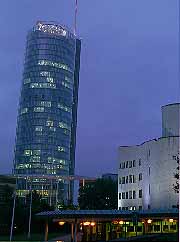
A view seen from the Alvar Aalto opera house
Photo:Keiichi Tahara |
1.The City of Essen
Essen, where the RWE Tower is located, is the business capital of the Ruhr region in the western part of Germany. Before World War II, it was the home of the Krupp family that enjoyed their prosperity from steel industries, utilizing the abundant coal and iron ore in the area. Most parts of the city were destroyed by the intensive bombing during the war, but have been restored completely. Now Essen, with a population of more than 600,000, the sixth largest city in Germany, is the service and economic center, in which eleven of the top hundred enterprises in the country have their head offices. The city is also known for its flourishing downtown area.
Essen is blessed with a rich natural and cultural environment, including Gruga Park and other large green zones, art museums, theaters and other attractions, too. The Aalto Theater, an opera house designed by Alvar Aalto, is especially well known as the representative building in the city.
2.In Harmony with Its Surroundings
The RWE Tower is situated in a prime location opposite to the Aalto Theater and Stadtgarten Park. It is not more than four or five minutes' walk from Essen Central Station. As is widely known, in Europe any new building is required to blend in with the other buildings in a street.
The RWE Tower has the main building set back from the street, along with the pergola the height of which is aligned with the eaves of neighbouring houses. There was still need to obtain the special sanction of the municipal authorities to construct the skyscraper. As Achim Nagel, one of the IOK architects, explained, churches dating back to ancient times were the only tall buildings. The 162m height of the tower, including an aerial on the top, is the highest point in North-Rhine Westphalia, but does not look isolated, when it is seen from anywhere in the city. Its abstract and clear external appearance is essentially in harmony with the row of stores and houses in the street.
3.The Situation prior to the Construction
RWE (Rheinisch-Westfaellisches Elektrizitaetswerk) AG originated in a power plant which began operating in 1898, but is now a corporate group having six affiliated enterprises for: energy; mines and materials; mineral oil and chemicals; industrial wastes, machinery, equipment, instruments and telecommunication; construction.
Their electric energy department is the largest in Germany. Hence, the RWE Tower is also known as "Power Tower."
In March, 1991, RWE AG, in conjunction with Ruhr Kohl AG, a coal mining company which shares the site, invited the public to participate in an international competition for the design of the group's headquarter building. In June of the same year, IOK won the first prize to be responsible for the design and the administration of the construction, plus the garden design. Three months after the completion of the actual design in early 1994, the RWE Tower with a total floor surface of 35,000sqm began to be constructed, and was finished in only 30 months, despite a pause of two months in the coldest season. The number of the workers on the site was not more than 700 even at the culmination. As well as the systematization of the design, the simultaneous progress of the technical development with the actual construction largely contributed to the speedy works. The builder and owner of the tower is Hochtief AG part of the RWE AG Group.
|
